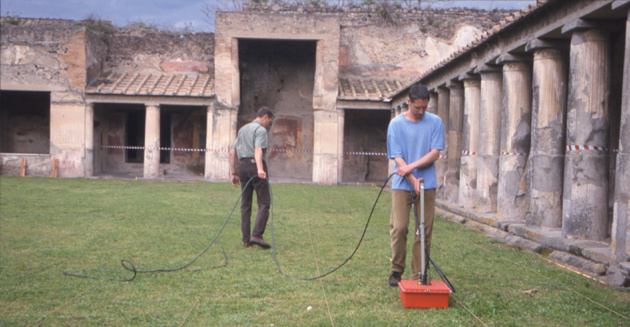Project History
Archaeological research on Greek and Roman ancient art and culture has a long tradition with the Bavarian Academy of Sciences and Humanities (BAdW). At the latest since 1807, when the academy received a new structure, classical studies became part of the research canon. Though at that time the Classical Archaeology had no representative with the Academy, renowned archaeologists like Aloys Hirt, Alexander Conze and Heinrich Schliemann were appointed external Academy members.
In 1865, Heinrich Brunn (1882-1894), Professor at the newly created Chair for Classical Archaeology at Munich University and author of the standard reference »Geschichte der griechischen Künstler«, was appointed to the Academy as the first representative. In 1895, under the aegis of his student and successor Adolf Furtwängler (1853-1907), one of the most significant representatives of German and international archaeology, archaeological field study in the Mediterranean region became part of the Academy’s work.
Excavations in Aegina
![The Academy’s first archaeological excavation: Adolf Furtwängler’s examination of the Temple of Aphaia on the island of Aegina in 1901. (A. Furtwängler [Hrsg.], Aegina: Das Heiligtum der Aphaia, München 1906, Tafel 9, 3)](/fileadmin/_processed_/b/0/csm_03_Aigina_c8902639a4.jpg)
In 1901 a very successful follow-up excavation organised by the Academy took place at the Temple of Aphaia in Aegina – the site where the famous pediment sculptures of the Aeginetans were found, since 1827 to be viewed in the Munich Glyptothek museum. The excavation not only provided more parts of the pediment sculptures but also numerous findings on the sanctuary’s history. Subsequently a foundation by the Rhineland vineyard owner and politician Emil Bassermann-Jordan secured the financing of further archaeological examinations. While Furtwängler started excavations of Aegina’s ancient island capital at Capo Colonna, his colleague Heinrich Bulle (1867–1945) in 1903 began supervising systematic excavations in Orchomenos, Boeotia, a Bronze Age settlement, providing insight into early Greek urban studies. Furtwängler’s untimely death, World War I and the loss of the foundation’s assets due to the inflation of 1923 brought these projects to a standstill.m Erliegen.
First Foundation of the Commission
With the support of the German Archaeological Institute (Deutsches Archäologisches Institut) and the Emergency Association of German Science (Notgemeinschaft der deutschen Wissenschaft) the excavations were resumed in 1924. In order to provide continuity for the project, in 1928 the Aegina Commission was founded with the Academy. Eduard Schwartz (1858-1940), Classical Philologist and Professor in Munich was appointed Chairman. From 1929, the Orchomenos project was also continued by Emil Kunze (1901-1994), future director of the German Archaeological Institute (Deutsches Archäologisches Institut) in Athens and long-time excavator in Olympia. The onset of World War II again put a halt on the archaeological excavations. Not till 1964 was the Aegina Commission revived under the leadership of ancient historian Helmut Berve (1896–1979). In 1968 Emil Kunze became his successor.
A New Direction
The excavations in Aegina had provided a wealth of results regarding the ancient trading city’s history and were continued in 1983 under new responsibility at the University of Salzburg, while the Aegina Commission began to pursue new objectives. The new Commission for the Exploration of Ancient Urbanism (Kommission zur Erforschung des antiken Städtewesens), headed by Paul Zanker, is dedicated to the exploration of the comprehensive phenomenon of ancient urbanism. In the course of the Academy’s structural reorganisation, towards the end of 2015 the Commission was transformed into the project »Archaeological Investigations and Excavations of Ancient Urbanity«.

Literature
Paul Zanker, Stefan Schmidt: Antike Lebenswelten am Mittelmeer. Akademie Aktuell 02/2009, S. 44–46.
Commission Chairmen
1928–1937: Eduard Schwartz (1858–1940), Philologist
1938–1951: Ernst Buschor (1886–1961), Archaeologist
1964–1967: Helmut Berve (1896–1979), Ancient Historian
1968–1982: Emil Kunze (1901–1994), Archaeologist
seit 1983: Paul Zanker (*1937), Archaeologist
